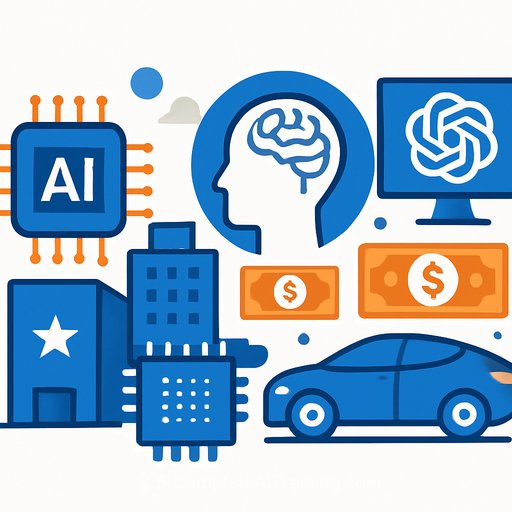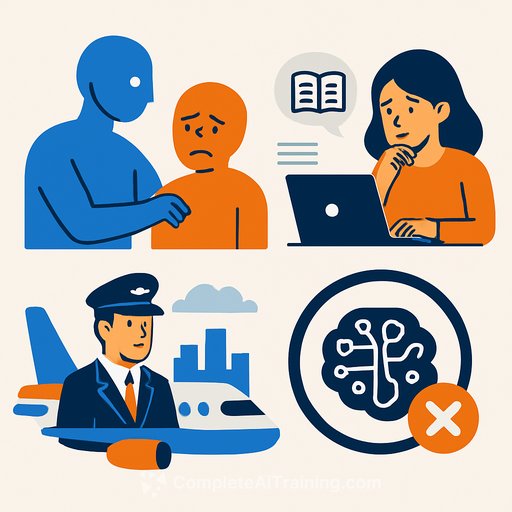Multi-Billion AI, Cloud, and Chip Deals: What Product Teams Need to Know
Big tech is writing massive checks to secure AI compute, cloud capacity, and chip supply. Google plans to invest $40B in three new data centers in Texas, and that's just one headline in a string of deals that will reset cost, access, and speed for AI products.
If you build products, this matters. Capacity, latency, and vendor leverage are shifting. The teams that plan for it will ship more, pay less, and avoid stalls when everyone else hits waitlists.
The headline moves
- Google: $40B over two years for three Texas data centers in Armstrong and Haskell Counties.
- Nvidia: Backing a group acquiring Aligned Data Centers for $40B.
- OpenAI x Broadcom: Collaboration to develop OpenAI's first in-house AI processors.
- AMD x OpenAI: Multi-year AI chip supply deal, with an option for OpenAI to take a stake in AMD.
- Nvidia x OpenAI: Plans to invest up to $100B in OpenAI.
- CoreWeave x Meta: $14B agreement for compute; Oracle in talks with Meta on a $20B cloud contract.
- Tesla x Samsung Electronics: $16.5B chip sourcing for next-gen AI.
- Meta x Scale AI: 49% stake for about $14.3B to fold labeling and data ops deeper into Meta's stack.
- Google x Windsurf: Key hires plus a $2.4B licensing deal.
- CoreWeave x OpenAI: Five-year contract worth $11.9B.
- Stargate Datacenter Project: SoftBank, OpenAI, and Oracle targeting up to $500B; announced by former President Donald Trump.
- Amazon x Anthropic: $4B investment.
Why this matters for product teams
Access to GPUs and specialty chips dictates training queues, inference latency, and unit economics. These deals signal more capacity, more providers, and more custom silicon-good news if you're ready to take advantage.
Expect shifts in pricing, region availability (watch Texas), and model options across clouds. Multi-cloud and hardware diversity will matter as much as model choice.
What to do in the next 90 days
- Map workloads: Separate training vs. inference, batch vs. real-time, latency-sensitive vs. cost-sensitive.
- Secure capacity: Reserve instances or commit spend with your top two providers (e.g., AWS, GCP, Oracle, CoreWeave). Negotiate preemption policies and burst options.
- Plan hardware flexibility: Ensure your stack runs on Nvidia and AMD. Validate PyTorch/JAX compatibility and test inference backends across vendors.
- Optimize models: Quantize where acceptable, cache prompts/embeddings, and shift non-critical inference to lower-cost tiers.
- Control data costs: Minimize egress with in-cloud pipelines. Use compact formats and streaming for large embeddings.
- Strengthen labeling: With Meta's Scale AI move, expect higher demand. Pre-book labeling capacity or build synthetic data workflows.
- Add region strategy: Place latency-critical services close to new US central regions as they come online; plan failover across clouds.
- Lock contract guardrails: SLAs for availability, capacity delivery timelines, price-protection bands, and clear exit/portability clauses.
Budget framing for 2025
- 35-50%: Compute commitments (reserved/burst capacity across two providers).
- 15-25%: Model efficiency (distillation, quantization, retrieval, fine-tune ops).
- 15-25%: Data pipeline (labeling, evaluation sets, governance, synthetic generation).
- 10-15%: Portability (multi-cloud infra, observability, and benchmarking).
Risks to watch
- Chip supply: Lead times can spike if a single model trend takes off. Keep a second hardware path warm.
- Energy constraints: New data centers compete for grid capacity; rollout timelines can slip.
- Vendor concentration: Avoid single-cloud lock-in for critical inference. Keep migration runbooks current.
- Cost volatility: Monitor spot pricing and preemption rates; blend reserved and on-demand.
- Policy and privacy: Track rules on data residency and model provenance that affect your architecture.
Signals that capacity is improving
- Announcements on Texas facility go-live dates and interconnect milestones.
- Foundry updates tied to Broadcom/AMD production for AI parts.
- Clouds offering larger reservations, shorter activation windows, and better egress terms.
Practical checklist for your roadmap
- Baseline latency and cost per request across at least two providers.
- Pilot one workload on AMD GPUs or custom accelerators to de-risk vendor shifts.
- Create a "capacity fallback" plan: smaller models, cheaper regions, or deferred features.
- Stand up evaluation suites that track quality, cost, and latency together.
- Review IP and data use clauses in every AI vendor contract.
The takeaway
Billions are flowing into AI compute, cloud, and chips. That means more options and better economics-if you prep your stack for flexibility and negotiate smart capacity now.
If your team needs structured upskilling to move faster, explore job-focused options at Complete AI Training: Courses by Job, or benchmark tooling with AI tools for generative code.
Your membership also unlocks:






